 W
WA banner can be a flag or other piece of cloth bearing a symbol, logo, slogan or other message. A flag whose design is the same as the shield in a coat of arms is called a banner of arms. Also, a bar-shaped piece of non-cloth advertising material sporting a name, slogan, or other marketing message.
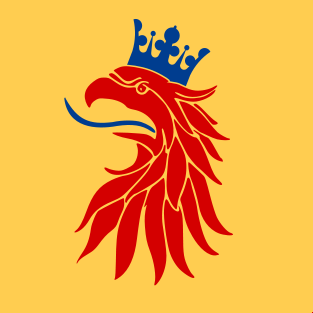 W
WA banner of arms is a type of heraldic flag which has the same image as a coat of arms, i.e. the shield of a full heraldic achievement, rendered in a square or rectangular shape of the flag.
 W
WA battle ensign is the name given to a large war ensign (flag) hoisted on a warship's mast just before going into battle.
 W
WA civil flag is a version of the national flag that is flown by civilians on nongovernmental installations or craft. The use of civil flags was more common in the past to denote buildings or ships not manned by the military.
 W
WAn ensign is the national flag flown on a vessel to indicate nationality. The ensign is the largest flag, generally flown at the stern (rear) of the ship while in port. The naval ensign, used on warships, may be different from the civil ensign or the yacht ensign. Large versions of naval ensigns called battle ensigns are used when a warship goes into battle. The ensign differs from the jack, which is flown from a jackstaff at the bow of a vessel.
 W
WA fanion is a small flag used by the French military; the equivalent of an American guidon or British company colour. The name derives from the Italian word gonfanone, or gonfanon. They were often attached to a small staff which was placed in the muzzle of a rifle.
 W
WThe gonfalon, gonfanon, gonfalone is a type of heraldic flag or banner, also known as Salebi often pointed, swallow-tailed, or with several streamers, and suspended from a crossbar in an identical manner to the ancient Roman vexillum. It was first adopted by Italian medieval communes, and later, by local guilds, corporations and districts. The difference between a gonfanon with long tails and a standard is that a gonfanon displays the device on the non-tailed area, and the standard displays badges down the whole length of the flag.
 W
WA green flag has various significances.
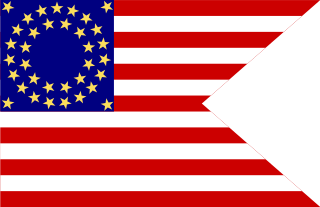 W
WIn the United States Army, Navy, Air Force, Marine Corps and Coast Guard, a guidon is a military standard that company/battery/troop or platoon-sized detachments carry to signify their unit designation and branch/corps affiliation or the title of the individual who carries it. A basic guidon can be rectangular, but sometimes has a triangular portion removed from the fly.
 W
WA jack is a flag flown from a short jackstaff at the bow (front) of a vessel, while the ensign is flown on the stern (rear). Jacks on bowsprits or foremasts appeared in the 17th century. A country may have different jacks for different purposes, especially when the naval jack is forbidden to other vessels. The United Kingdom has an official civil jack; the Netherlands has several unofficial ones. In some countries, ships of other government institutions may fly the naval jack, e.g. the ships of the United States Coast Guard and the National Oceanic and Atmospheric Administration in the case of the US jack. Certain organs of the UK's government have their own departmental jacks. Commercial or pleasure craft may fly the flag of an administrative division or municipality at the bow. Merchant ships may fly a house flag. Yachts may fly a club burgee or officer's flag or the owner's private signal at the bow. Practice may be regulated by law, custom, or personal judgment.
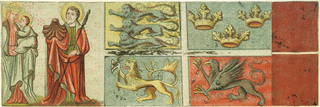 W
WA maritime flag is a flag designated for use on ships, boats, and other watercraft. Naval flags are considered important at sea and the rules and regulations for the flying of flags are strictly enforced. The flag flown is related to the country of registration: so much so that the word "flag" is often used symbolically as a synonym for "country of registration".
 W
WIn military organizations, the practice of carrying colours, standards or guidons, both to act as a rallying point for troops and to mark the location of the commander, is thought to have originated in Ancient Egypt some 5,000 years ago. The Roman Empire also made battle standards a part of their vast armies. It was formalized in the armies of Europe in the High Middle Ages, with standards being emblazoned with the commander's coat of arms.
 W
WA national flag is a flag that represents and symbolizes a given nation. It is flown by the government of that nation, but usually can also be flown by its citizens. A national flag is typically designed with specific meanings for its colours and symbols, which may also be used separately from the flag as a symbol of the nation. The design of a national flag is sometimes altered after the occurrence of important historical events. The burning or destruction of a national flag is a greatly symbolic act.
 W
WA naval ensign is an ensign used by naval ships of various countries to denote their nationality. It can be the same or different from a country's civil ensign or state ensign.
 W
WA Nordic cross flag is a flag bearing the design of the Nordic or Scandinavian cross, a cross symbol in a rectangular field, with the centre of the cross shifted towards the hoist.
 W
WThe commissioning pennant is a pennant flown from the masthead of a warship. The history of flying a commissioning pennant dates back to the days of chivalry with their trail pendants being flown from the mastheads of ships they commanded. Today, the commissioning pennants are hoisted on the day of commissioning and not struck until they are decommissioned. Some navies have a custom of flying a "paying off" or "decommissioning pennant," the length of which often reflects the length of service of the warship.
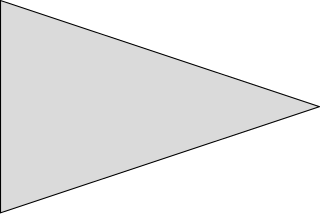 W
WA pennon or pennant is a flag that is larger at the hoist than at the fly. It can have several shapes, such as triangular, tapering or triangular swallowtail.
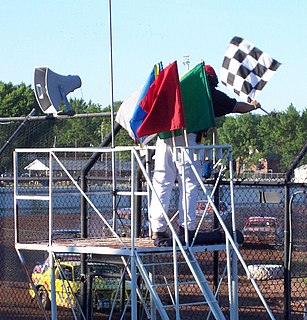 W
WRacing flags are traditionally used in auto racing and similar motorsports to indicate track condition and to communicate important messages to drivers. Typically, the starter, sometimes the grand marshal of a race, waves the flags atop a flag stand near the start/finish line. Track marshals are also stationed at observation posts along the race track in order to communicate both local and course-wide conditions to drivers. Alternatively, some race tracks employ lights to supplement the primary flag at the start/finish line.
 W
WA rainbow flag is a multicolored flag consisting of the colors of the rainbow. The designs differ, but many of the colors are based on the spectral colors of the visible light spectrum. When Isaac Newton first saw a rainbow through a prism, he labeled the colors red, orange, yellow, green, blue, indigo, and violet. However, when not seen through a prism, the color he deemed "blue" is actually blue-green, or cyan, what he called "violet" is today known as dark blue, and "indigo" is a normal blue.
 W
WA service flag or service banner is a banner that family members of those serving in the United States Armed Forces can display. The flag or banner is officially defined as a white field with a red border, with a blue star for each family member serving in the Armed Forces of the United States during any period of war or hostilities. A gold star represents a family member who died during military operations, including those who lost their lives during World War I, World War II, or any subsequent period of armed hostilities in which the United States was engaged before July 1, 1958, and those who lost or lose their lives after June 30, 1958:while engaged in an action against an enemy of the United States; while engaged in military operations involving conflict with an opposing foreign force; or while serving with friendly foreign forces engaged in an armed conflict in which the United States is not a belligerent party against an opposing armed force;
 W
WIn vexillology, a state flag is either the flag of the government of a sovereign state, or the flag of an individual federated state.
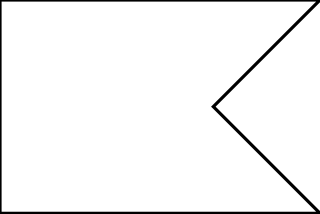 W
WIn flag terminology, a swallowtail is eithera V-shaped cut in a flag that causes the flag to end in two points at the fly; or any flag that has this V-shaped cut.
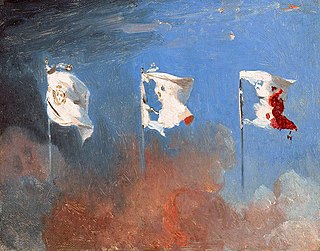 W
WA tricolour or tricolor is a type of flag or banner design with a triband design which originated in the 16th century as a symbol of republicanism, liberty or indeed revolution. The flags of France, Italy, Romania, Mexico, and Ireland were all first adopted with the formation of an independent republic in the period of the French Revolution to the Revolutions of 1848, with the exception of the Irish tricolour, which dates from 1848 but was not popularised until the Easter Rising in 1916 and adopted in 1919.
 W
WUmbul-umbul, also called rérontek or, archaically, tunggul, are a type of flag or pennant made of a strip of cloth whose longer side is attached to a pole. They are used in the traditional culture of Java and Bali, Indonesia, where they are carried in festivals and serve other decorative purposes. Red and white Umbul-umbuls are raised throughout Indonesia along streets in August to commemorate the Indonesian independence day.
 W
WA war flag, also known as a military flag, battle flag, or standard, is a variant of a national flag for use by a country's military forces when on land. The nautical equivalent is a naval ensign. Under the strictest sense of the term, few countries today currently have proper war flags, most preferring to use instead their state flag or standard national flag for this purpose.
 W
WWhite flags have had different meanings throughout history and depending on the locale.